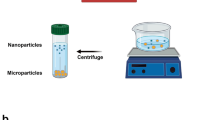Abstract
Biocompatible polysaccharides, such as alginate and chitosan are widely used as drug carriers. Microspheres based on the electrostatic interaction between these two polymers have been attractive as a means to deliver protein drugs because the use of organic solvents can be avoided during their preparation. On the other hand, the mechanisms for drug release, such as disintegration of microspheres, are not completely understood. This paper examined the phenomena of disintegration of the core-shell type microspheres consisting of alginate and chitosan. The microspheres formed by either chitosan-coated alginate or alginate-coated chitosan were generated using a labmade instrument consisting of a syringe pump connected to a glass nozzle. Using fluorophore-labeled polysaccharides, the disintegration of each polymer layer from the microspheres was monitored as a function of time. The alginate- coated chitosan microspheres demonstrated enhanced stability with increasing concentration of the chitosan core. The presence of an alginate shell itself also increased the stability of the microsphere compared to the microspheres without an alginate coating. The chitosan concentration, however, did not have any effect on the stability of the chitosan-coated alginate microspheres. The microspheres synthesized with alginate in the core demonstrated concentration-dependent stability. In these microsphere experiments, the microsphere stability was found to be related directly to the protein release kinetics. In the alginate/chitosan-based microspheres, the disintegration property is the primary factor modulating the encapsulated drug release, which suggests the easiest simple method for time-dependent protein drug delivery.

Similar content being viewed by others
References
K. L. Douglas and M. Tabrizian, J. Biomater. Sci., Polym. Ed., 16, 43 (2005)
Y. Kaneko and J. Kadokawa, J. Biomater. Sci., Polym. Ed., 17, 1269 (2006)
S. Ye, C. Wang, X. Liu, and Z. Tong, J. Biomater. Sci., Polym. Ed., 16, 909 (2005)
S. W. Xu, Y. Lu, J. Li, Y. F. Zhang, and Z. Y. Jiang, J. Biomater. Sci., Polym. Ed., 18, 71 (2007)
A. D. Sezer and J. Akbuga, J. Microencapsul., 16, 195 (1999)
A. D. Sezer and J. Akbuga, J. Microencapsul., 16, 687 (1999)
A. J. Ribeiro, R. J. Neufeld, P. Arnaud, and J. C. Chaumeil, Int. J. Pharm., 187, 115 (1999)
K. Y. Lee, E. Alsberg, and D. J. Mooney, J. Biomed. Mater. Res., 56, 228 (2001)
L.-S. Liu, S.-Q. Liu, S. Y. Ng, M. Froix, T. Ohno, and J. Heller, J. Control. Release, 43, 65 (1997)
P. R. Hari, T. Chandy, and C. P. Sharma, J. Appl. Polym. Sci., 59, 1795 (1996)
C. Lee, H Jeong, D. Kim, and K. Lee, Macromol. Res., 16, 429 (2008)
P. Prabu, K. W. Kim, N. Dharmaraj, J. H. Park, M. S. Khil, and H. Y. Kim, Macromol. Res., 16, 303 (2008)
H. Byun, B. Hong, S. Y. Nam, S. Y. Jung, J. W. Rhim, S. B. Lee, and G. Y. Moon, Macromol. Res., 16, 189 (2008)
H. J. Kong, D. Kaigler, K. Kim, and D. J. Mooney, Biomacromolecules, 5, 1720 (2004)
T. Boontheekul, H. J. Kong, and D. J. Mooney, Biomaterials, 26, 2455 (2005)
K. Lee and S. Lee, Macromol. Res., 16, 293 (2008)
P. De Vos, B. J. De Haan, G. H. Wolters, J. H. Strubbe, and R. V. Schilfgaarde, Diabetologia, 40, 262 (1997)
C. M. Silva, A. J. Ribeiro, D. Ferreira, and F. Veiga, Eur. J. Pharm. Sci., 29, 148 (2006)
S. Kim, S. Y. Chae, K. Na, S. W. Kim, and Y. H. Bae, Biomaterials, 24, 4843 (2003)
K. G. Desai, C. Liu, and H. J. Park, J. Microencapsul., 23, 79 (2006)
O. Gaserod, A. Sannes, and G. Skjak-Braek, Biomaterials, 20, 773 (1999)
O. Gaserod, O. Smidsrod, and G. Skjak-Braek, Biomaterials, 19, 1815 (1998)
M. Leonard, M. R. De Boisseson, P. Hubert, F. Dalencon, and E. Dellacherie, J. Control. Release, 98, 395 (2004)
X. Z. Shu and K. J. Zhu, Eur. J. Pharm. Biopharm., 53, 193 (2002).
Author information
Authors and Affiliations
Corresponding author
Rights and permissions
About this article
Cite this article
Nam, Y.S., Bae, M.S., Kim, S. et al. Mechanism of albumin release from alginate and chitosan beads fabricated in dual layers. Macromol. Res. 19, 476–482 (2011). https://doi.org/10.1007/s13233-011-0501-1
Received:
Revised:
Accepted:
Published:
Issue Date:
DOI: https://doi.org/10.1007/s13233-011-0501-1




